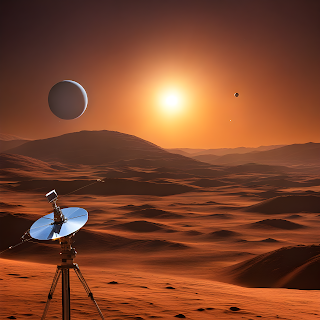Exploring the Enigmatic World of Mercury and BepiColombo Mission: Unveiling Mysteries and Future Possibilities
 |
| Probe on Mercury |
In this blog we talk about Bepicolombo Mission and much more about mercury in this blog. We discuss this point in this article:
1.The Oddities of Mercury
2.Comparing Distances: Earth vs Mercury
3.Duration of Days and Years on Mercury
4.Venus vs Mercury in hotness
5.Comparative Analysis Mercury core and Magnetic field
6.NASA's Exploration Mission: Messenger and Bepicolombo
7.Challanges of Exploration Mercury
8.The Future of Bepicolombo Mission
9.Mercury: A potential for future civilization Advancements?
Hi! My name is Noel Gill. And let's start this article.
Mercury, the smallest and innermost planet of our solar system, has captivated scientists and space enthusiasts for decades. The planet’s proximity to the Sun and its peculiar characteristics have made it an intriguing subject for space exploration. Enter BepiColombo, a joint endeavor by the European Space Agency (ESA) and the Japan Aerospace Exploration Agency (JAXA), designed to unlock the mysteries shrouding this enigmatic world.
The Oddities of Mercury
Mercury, often referred to as the "messenger of the gods," is an oddity in our cosmic neighborhood. It’s positioned approximately 48 million miles away from Earth, making it the closest planet to our home planet.
Comparing Distances: Earth vs. Mercury
In contrast, Mercury is situated at a mean distance of about 36 million miles from the Sun, substantially closer than Earth's average distance of approximately 93 million miles. This proximity subjects Mercury to extreme temperature fluctuations, ranging from scorching highs of about 800 degrees Fahrenheit during the day to chilling lows of -290 degrees Fahrenheit at night.
Duration of Days and Years on Mercury
Mercury's days and years are unusual. A day on Mercury lasts about 176 Earth days due to its slow rotation, while its year is relatively shorter, spanning only about 88 Earth days.
Venus vs Mercury in hotness
When comparing the hotness of Venus and Mercury, it's important to consider different factors that contribute to their extreme temperatures.
Venus:
Atmosphere: Venus has a thick atmosphere composed mainly of carbon dioxide and clouds of sulfuric acid. This dense atmosphere creates a greenhouse effect, trapping heat and leading to extremely high surface temperatures.
Runaway Greenhouse Effect: The greenhouse effect causes the surface of Venus to experience scorching temperatures, reaching an average of about 864 degrees Fahrenheit (462 degrees Celsius), making it the hottest planet in our solar system despite being farther away from the Sun than Mercury.
Mercury:
Proximity to the Sun: Despite being the closest planet to the Sun, Mercury's lack of a substantial atmosphere means it doesn’t retain heat in the same way as Venus. During its daytime, the side facing the Sun can reach temperatures as high as 800 degrees Fahrenheit (430 degrees Celsius). However, due to its lack of an atmosphere, temperatures drop drastically during its long and cold nights, reaching lows of about -290 degrees Fahrenheit (-180 degrees Celsius).
Comparative Analysis: Mercury's Core and Magnetic Field
The core of Mercury is proportionally larger, constituting about 85% of the planet's radius, whereas Earth's core is only about 55%. Additionally, Mercury possesses a magnetic field, albeit significantly weaker than Earth's.
NASA's Exploration Missions: MESSENGER and BepiColombo
Prior to BepiColombo, NASA's MESSENGER mission offered valuable insights into Mercury's surface, atmosphere, and magnetic field, significantly advancing our understanding of this planet.
Challenges of Exploring Mercury
Mercury exploration poses unique challenges compared to other celestial bodies. Its proximity to the Sun causes extreme heat, making spacecraft operations and instrument functionality a formidable task. Moreover, its lack of atmosphere means no protection against solar radiation.
The Future of BepiColombo Mission
The BepiColombo mission aims to delve deeper into Mercury's mysteries, focusing on its geology, magnetosphere, and surface characteristics. Future findings are anticipated to unravel more about its formation and evolution.
Mercury: A Potential for Future Civilization Advancements?
As we ponder the possibilities of Type 2 civilizations, harnessing the immense solar energy in Mercury's proximity might be envisioned for advanced solar panel manufacturing. However, the challenges associated with this endeavor remain substantial due to the harsh conditions and the complexities of interstellar engineering.
In conclusion, Mercury, with its stark peculiarities and scientific significance, remains a tantalizing subject for exploration. The ongoing BepiColombo mission, along with potential future advancements, promises to unravel more of the mysteries locked within this mesmerizing celestial body.
The exploration of Mercury serves not only as a testament to human curiosity but also as a beacon of potential advancements and scientific breakthroughs that could shape our understanding of the universe.
Comments
Post a Comment